
One small injustice.
One of our friends — a working class white woman — was in trouble and called my wife Rose. Her landlord was trying to force her out of her apartment, despite the fact that she had five months left on her lease. The landlord had ordered workmen to break into her apartment to take measurements for its demolition. Clothes and other belongings were left strewn around. Nothing was stolen, so this was clearly a move to terrorize our friend into moving. The landlord told the friend that he had bought the building for “development,” and our friend would have to move. Amazingly, he also admitted that his purchased had not even been approved. He was invading a property that was not even legally his.
Rose hopped on the computer and checked out the building’s property listings and its sale history. She learned that her old landlord had sold it to another buyer at regular value just a few months ago. That buyer then sold it for a massive profit, and then it was resold it for a huge loss. As a real estate insider confirmed to us, “This is a clear case of money-laundering!” We posted the details on Facebook.
The very next day, the latest landlord wannabe told our friend that the deal had fallen through. A few days later, he then proceeded to continue with eviction proceedings. “I bought the building, not the lease.”
Rose looked up Florida tenant law, and confirmed that when you bought a property with leased units, the terms of the lease remained in effect until the lease expired. Rose then called the landlord. He refused to talk to her. Rose quickly cited the shady sales values she had posted. The landlord caved in and agreed to honor the lease and would otherwise behave himself.
One large injustice.
In 1991, the City of St. Petersburg built Tropicana Field, a baseball stadium for the Tampa Bay Rays. They built it over a graveyard of Black people, quite literally. The formerly vibrant Black family community just south of Central, known as the Gas Plant district, was leveled, its graveyard paved over. Nearly 1,000 Black families were forced out along with 100 Black-owned businesses. Promises of restitution were made. Those promises were broken. Now the Rays are leaving town, and Tropicana Field itself is to be leveled, replaced by shops and housing for the middle-class and the tourist trade. One more thing. In one corner of the site, they want to build a brand new baseball stadium.
Naming the beast.
 Obviously the two injustices cited above are of a qualitatively different scale. Yet they share a common link, and its name is Gentrification —products of the city’s onrushing drive to gentrify every square inch of St. Pete. At present, per the Tampa Bay Times:
Obviously the two injustices cited above are of a qualitatively different scale. Yet they share a common link, and its name is Gentrification —products of the city’s onrushing drive to gentrify every square inch of St. Pete. At present, per the Tampa Bay Times:
“Nearly a half billion dollars worth of construction is underway or expected to start this year in the city’s once somnolent downtown. Museums, apartments, condos, a new police station and a dozen other projects mark one of the biggest downtown building booms in St. Petersburg’s 130-year history.”
Some of it is as stark as the St. Pete skyline. Now under construction and already blighting that corporate skyline is the towering ONE St. Petersburg which proclaims that it is “Soaring to new heights in the heart of downtown” and introducing a “bold new vision for contemporary urban living. ONE city block. 41 stories. 253 luxury condominium residences. 174 hotel rooms. A new destination for shopping, dining and more. An iconic new address – with endless views and infinite possibilities in every direction. Setting a new standard for excellence.” Going for the multi-story gold, however, is the entire block of 400 Central Avenue, bought up by New York billionaire John Catsimatidis, where plans for a 52-story tower have been released.
In addition to St. Pete’s disfigured skyline, a quick snapshot shows:
- Rents are being raised throughout the city, with evictions, renovations and demolitions, for those the city is hoping to attract, i.e., “entrepreneurs, young professionals, college students, and other highly desired groups.”
- Trailer parks, the last refuge for the elderly poor, are being closed down for complete demolition to make way for upscale condos.
- After the Walmart at 22nd St. S. 18th Ave. shut its doors, there are NO supermarkets left on the South Side, only price-gouging corner stores. They call it a “food desert.”
- Over the past decades, St. Pete’s City Council districts have been gerrymandered so as to minimize the impact of the Black vote, particularly in now-barely majority-Black District 6 where the boundaries have been changed to cut out Black voters and add middle-class whites.
- The police have adopted the “Intelligence-Led/Data-Driven Policing Model” for “identifying and forecasting crime trends and isolating ‘hot spot’ areas,” i.e., flooding the South Side with cops as was done when they shut down the South Side on Martin Luther King, Jr. Day.
- St. Pete’s transportation system is skeletal at best.
- Rents are skyrocketing along Central Avenue off of Downtown, and favorite local businesses are being forced to shut down, making way for “world-class” dining and boozing establishments, along with massive condos and office towers.
- The homeless are rousted from the city’s Downtown “Prohibited Zone,” where panhandling is prohibited. The homeless are shipped to Safe Harbor, a “jail diversion program” run like a jail by the Pinellas County Sheriff’s Department.
- The Alfred Whitted sewage plant was shut down, in the process committing 89 felonies and leading to a complete sewage breakdown that dumped over one billion gallons of raw sewage into Tampa Bay, and onto and into the streets and homes of the largely Black South Side. Every heavy rainfall leads to another dumping.
- At the same time, the city has just allocated another $500,000 to fight a lawsuit brought against it for openly breaking the federal Clean Water Act.
- They have a Pulitzer Prize-winning school system, subject of a series in the 2016 Tampa Bay Times which exposed that “The schools examined in the report were found to have ‘the greatest concentration of academic failure in all of Florida,’ with alarming rates of violent behavior in elementary schools. … This is the story of how district leaders turned five once-average schools into Failure Factories.”
- The South Side is renamed “Midtown,” forewarning us of its intended annexation to Downtown.
 But merely naming the beast does not immediately offer a clue as to how Gentrification is to be fought. Looking at each point individually, they appear as a series of “natural” processes at work. Budget constraints, the “general” economy, people moving out. So what else is new.
But merely naming the beast does not immediately offer a clue as to how Gentrification is to be fought. Looking at each point individually, they appear as a series of “natural” processes at work. Budget constraints, the “general” economy, people moving out. So what else is new.
Dozens of middle-class white people pack the City Council chambers (unsuccessfully) to tell the Development Review Commission that the proposed Bezu Tower would mar the beauty of their East Side neighborhood. The South Side community — drowned by a billion gallons of raw sewage — can hardly be expected to care about East Side luxury homes losing some of their sunshine to a new high-rise.
Some might even wonder what some of the above points have to do with Gentrification. A first step is to look at the power dynamics in motion in what the politicians like to call the “Sunshine City,” and what others call the “City that Stinks,” as the politicians pretend to systematically carry out the City of St. Petersburg’s Comprehensive Plan, an obscure and confusing 311-page document that includes their “master development plan.”
Who rules St. Pete?
The city’s official site brags of having “One of the most concentrated financial services sectors in Florida and the region — double that of the average American community.” The city states:
“Financial services is the largest industry sector in St. Petersburg employing over 14,000 individuals in high-paying careers. … As Florida’s financial services leader, St. Petersburg is a major exporter with billions in financial services-based exports annually. … “It is the headquarters for the financial services firm of Raymond James, the largest financial services firm outside of Wall Street and a Fortune 500 company.”
(Raymond James ranks 8th among top ten firms for financial adviser misconduct.) It also harbors giants Franklin Templeton, Wells Fargo, Bank of America, Transamerica, and Allstate. Concerning its economy:
Tampa Bay Times: “There’s a good reason Florida is known as a ‘banking colony.’ Of the 66 banks scrapping for business in the Tampa Bay market, 30 — 45 percent of them — are based outside Florida and control the vast majority of deposits in this state and in this metro market. Many of the 19 out-of-state banks operating here are mid-sized and are most aggressive in buying the smaller banks headquartered here in order to grow in Florida and acquire the local banking and community expertise to gain future business.”
However, ruling is not the same as government. That requires minions.
Who governs St. Pete?
In last year’s mayoral election, both former Mayor Rick Baker and current Mayor Rick Kriseman ran on gentrification dollars, and city government is one complex, all-embracing gentrification machine. Kriseman, the Democrat, had the support of the official progressive community, despite his pitiful track record. During last year’s campaign for mayor, Kriseman unveiled his planned city budget on June 19, not without complaint.

Tampa Bay Times: “Midtown and its persistent poverty was also a topic raised by several speakers. The loss of Walmart in Tangerine Plaza and other closures were blamed on a lack of direction from City Hall. ‘There was either no plan or a weak incremental plan that did not make a difference,’ said Larry Newsome, a developer involved in the failure of Tangerine Plaza and the closing of Sylvia’s restaurant in the historic Manhattan Casino. … Kriseman said he understood those concerns.”
Kriseman and Baker did not go unchallenged. Per the Tampa Bay Business Journal:
“Front-runners Rick Kriseman, the incumbent mayor, and former Mayor Rick Baker took a back seat to what most have considered a fringe candidate who wants reparations for black residents. The outpouring of support for Jesse Nevel, a 27-year old supporter of the African solidarity group known as Uhuru, shook the foundation of conventional campaign wisdom for the second time in less than a week.’ We have to address the 800-pound gorilla in this room and his name is gentrification,’ Nevel said.”
But as former Black St. Pete Police Chief Goliath Davis explained:
“The current mayor, Rick Kriseman, is a Democrat who ignores the community, oversees the loss of basic services and presides over community gentrification. Yet, he insists Midtown and surrounding communities should vote for him simply because of his party affiliation.”
So it was that the St. Pete’s black community flirted with Republican Rick Baker, and then reluctantly turned out to give Kriseman his margin of victory.
However any given election turns out, St. Pete has its own Permanent Government, a “Deep State” all its own. Take a look at the city’s own site, and you will see a mind-numbing array of 42 departments and 33 boards and committees. They are by-and-large administrative. Their members are generally political appointees and/or staff members with various responsibilities. They include representatives from community organizations and neighborhood associations, prominent churches, groups like the Urban League and NAACP, local businesses, and so-called “community leaders.” City Councilmembers each sit on 3–5 different committees, and other members are staff people or political appointees being rewarded for “service” to the community.
One commission stands out, however. The Development Review Commission, where the corporate heavy hitters reside. Its seven current members include:
- Commission Chair Joe Griner comes from Griner Engineering, “registered in 24 states and Puerto Rico, our firm offers mechanical, electrical, plumbing and fire protection engineering design services as well as LEED Certification and building commissioning services throughout the Tampa Bay area, the U.S and abroad. Our project background consists of municipal and governmental facilities, educational facilities, office buildings, healthcare facilities, multi-family/mixed-use dwellings, industrial buildings, laboratories, retail facilities and food service.”
- Richard Doyle, of Richard Doyle Real Estate, “a full service Real Estate Company with offices in Tampa and Clearwater Florida. Service areas include both Hillsborough and Pinellas County. www.richarddoylerealestate.net RDRE has a separate division, specializing in marketing and managing Real Estate Owned (REO/ Bank Owned) Properties throughout Pinellas, Hillsborough and Pasco County. Attracting the largest clients including Fannie Mae, Freddie Mac, Bank of America and Chase.”
- Darren Stowe, Vice Chair, Environmental Consulting & Technology, Inc. (ECT).” Private and government-sector clients alike know that they can reduce their liability exposure … meet compliance requirements in a more timely and economical manner … aggressive advocacy for your concerns and interests, and the business skills and acumen necessary to consistently and reliably deliver results.”
- Bob Schumaker, of Freeman, Goldis & Cash, which has represented Northern Trust, Synovus Bank of Florida, Republic Bank, Crimson Capital, JP Morgan Chase, Progressive Insurance Company, with specialties in Collections (“cost effective and expedited recovery actions against delinquent debtors”) and Bankruptcy (“specialize in advocating creditors’ rights”). He “has handled large, complex commercial real estate transactions … [and] the purchaser of a portion of the largest hotel complexes on St. Petersburg Beach and the purchaser of the largest office building in downtown St. Petersburg.
- Ann Vickstrom, wife of Daniel Vickstrom, who runs Vickstrom Engineering Services, Inc. (VES). VES has worked with all local permitting agencies including the Cities of Tampa, Saint Petersburg, Clearwater, Dunedin, and Largo; Hillsborough, Pinellas and Manatee Counties; as well as the state permitting agencies of SWFWMD, SFWMD, and the FDEP. Ann Vickstrom herself is a prominent fixture of St. Pete high society and the local charity scene.
- Chuck Flynt, Property manager and senior leasing agent of Arvana Property Management, which “manage the corporate responsibilities of our investors. … provide swift decision making on complex issues that may result in savings to the investor.
- Calvin Samuel, President at CSJM Architects, which “primarily operates in the Architectural Services business / industry within the Engineering, Accounting, Research, and Management Services sector.
Note what the name of the commission is “Development REVIEW Commission.” To be sure, the city’s Master Development Plan and all amendments to the Master Development Plan shall require Development Review Commission (DRC) approval. But these commissioners and the corporate powers they represent are not in the business of reviewing much of anything. Rather, they are experts in ramming projects through at the service of the developers.
They are the foxes guarding the henhouse.
Master Plans abound. Within the Comprehensive Plan are references to 13 other different Master Plans, including five dedicated to just water and sewage. Section 16.20.140.3 of the Municipal Code even specifies “Requirements for master development plans.”
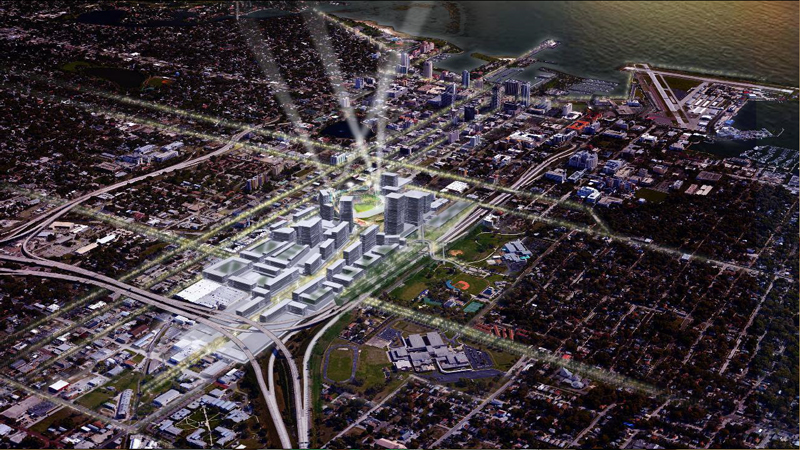 But exactly what is it that they are planning?
But exactly what is it that they are planning?
“A plan so cunning” …
… as Black Adder said, that “you could put a tail on it and call it a weasel.”
A common technique that governments, politicians and corporate lawyers regularly use to hide things is to bury them in an overwhelming morass of facts, so as to obscure what may be pertinent. Thus the Comprehensive Plan is loaded with specifications and promises and lofty vision. 24 pages devoted just to vision, with a typical format such as a “Parks & Leisure Mission Statement” waxes poetic: “St. Petersburg will be a community of parks dedicated to the purposes of rest, reflection, recreation and social interaction. Parks shall be easily accessible to everyone and they shall be interlinked through a system of tree – canopied sidewalks, bikeways, greenways, waterways when present, and trails that provide connectivity and a sense of place and identity to all areas of the city. The park system shall promote responsiveness to each neighborhood and citizen need, and shall provide beauty and meaning through art, ornament, education, environmental demonstration, and well-maintained garden architecture and recreational facilities.”
After listing “likes” and “dislikes,” it says its vision will result in a “Beautiful parks and trails system,” etc., etc.
On and on and on for 311 pages with specifications for bulbs for traffic lights, energy measures, and monitoring bicycle accidents and phrases like “in cooperation with” and “continue to participate” and “adequate level of service” and “shall encourage” and “adequate funding” and “must be compatible with” on and on.
None of which gives the gentle reader the slightest idea of what is going on.
Two more plans are written in a similar vein:
Community Redevelopment Plan.
Launched in 2015, “The Community Redevelopment Agency will engage in land assembly, disposition and development efforts; infrastructure and streetscaping improvements; small business assistance through mentoring and retention programs as well as financial grants and loans; incentivizing affordable and market –rate housing development through financial grants and loans; support for workforce development and work readiness programs; and marketing and technical assistance.”
The targeted Community Redevelopment Area is south of Central Avenue down to 30th Avenue South, from 40th Street South and east almost to Tampa Bay. Its essence is the provision of small loans, “micro-loans” and grants to develop the above target area, to revitalize the Black community. It is pathetically underfunded through things like the “Penny for Pinellas” 1% sales tax, and funneling whatever federal funds might still be available. The effect on poverty is less than negligible, as it is actually designed to dole out small loans to net a cadre of Black entrepreneurs beholden to the Democratic Party, which is certainly NOT committed to ending poverty anywhere other than Wall Street.
2020 Plan.
2020 Plan, launched in 2014, is certainly more grandiose: “The 2020 Plan is a collective impact initiative designed to reduce the poverty rate by 30% by 2020 in South St. Petersburg, an area that occupies about one-third of the City of St. Petersburg and is the largest concentration of poverty in Pinellas County, Florida.”
The plan lists 120 participants, including such major players as the city itself, energy giant Duke, Wells Fargo, and the charity octopus United Way. The Plan proudly describes this organizational powerhouse’s “Impact since 2014”:
$2.4 million raised for business services
14 new programs for business growth
393 entrepreneurs trained and supported Capacity Growth
For perspective, the projected city budget for 2018: $535,454,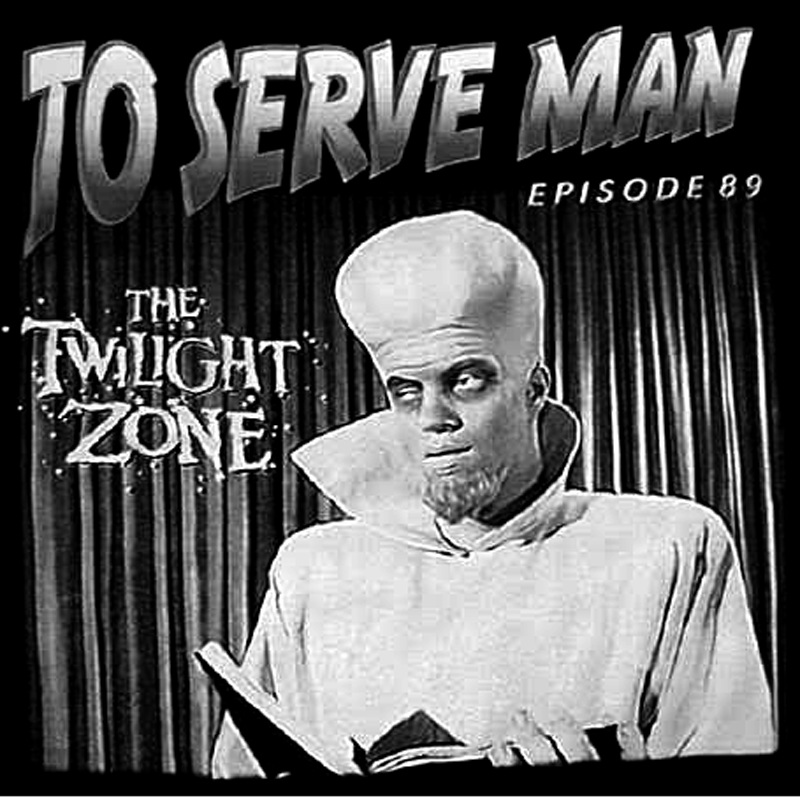 000.
000.
Tampa Bay Times: “Though the city has helped steer hundreds of millions of dollars into the neighborhoods around Midtown since 1999, they remain stuck in poverty. Adjusted for inflation, the average household’s income has gone down. … The number of households earning less than half of the federal poverty line has gone from 15 percent in 1999 to 19 percent.” This despite a rise in the city’s overall median income.
Their planning documents are loaded with the faces of smiling Black families enjoying the wonders of all that new development. It’s all couched in terms of serving the Black community. But it all echoes that famous Twilight Zone episode where we learn at the end, “It’s a cookbook!”
How do we find the real deal?
For a reality check, let us turn to the St. Petersburg Grow Smarter Initiative, compiled by the Chamber of Commerce in 2014 and stating that “the City of St. Petersburg should serve as the coordinator of strategic implementation.”
The Grow Smarter Initiative was the brainchild of Market Street Services Inc. at the behest of the St. Petersburg Area Chamber of Commerce. Extracted from the Grow Smarter Initiative is the following:
“St. Petersburg … is denser than almost every major city in Florida and has limited large sites available for major residential, commercial, or industrial projects. As such, the redevelopment and revitalization of key districts and corridors in St. Petersburg will be the principal means to enhance the community’s housing stock, office product, walkability, transit viability, and ensure there is sufficient space for business expansion and relocation.”
In other words, development means cannibalizing existing neighborhoods.
“A particularly timely early focus could be on downtown-adjacent neighborhoods as development pressure from St. Petersburg’s top investment district radiates outward from the core.”
“[T]he city in fact does have multiple tracts and buildings that can accommodate new investment. Among these are: the Dome Industrial District. … Eighty-six continuous acres in the heart of downtown St. Petersburg could be a lucrative development opportunity if the Tampa Bay Rays move.”
“Believing that a comprehensive, aggressive, and holistic antipoverty strategy would be the most impactful tactic to improve standards of living in South St. Petersburg, key leaders have developed the 2020 Plan as the principal agenda for raising incomes, reducing crime, and revitalizing neighborhoods.”
“A plan developed for the Southside CRA (Community Redevelopment Area) will channel investments through a 2020 Plan implementation network of over 50 churches, faith-based non-profits, and other organizations.”
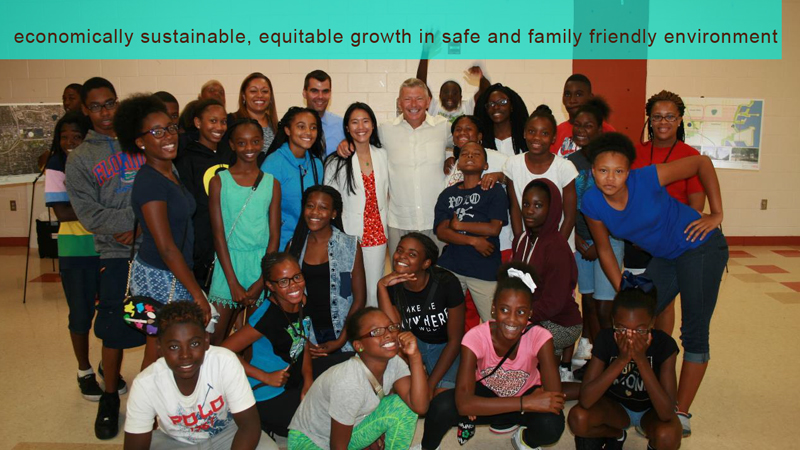 The primary target for development is clearly the South Side. However, developing the South Side poses certain problems.
The primary target for development is clearly the South Side. However, developing the South Side poses certain problems.
“Addressing potential threats to this quality of life will also be a critical strategy to ensure that the city’s momentum is not curtailed by factors that could diminish its destination appeal to constituencies of all types. Two key current threats are public safety and housing. A key theme of Grow Smarter public input, the housing stock in St. Petersburg was said to be sub-optimal for the attraction and retention of families and skilled professionals. A preponderance of smaller post-World War II detached houses and limited land available for new residential development have contributed to a deficit in quality housing options at multiple price points.”
However, this “deficit in quality housing options” is less a liability than an opportunity, as residents are forced out, and property is available on the cheap.
“[L]inkages between housing efforts and Grow Smarter talent development strategies should be fostered so that preferences of Millennials, mid-career professionals, recent graduates, entrepreneurs and other key workforce constituencies are incorporated into the analysis. At the city level, St. Petersburg implements a Neighborhood Stabilization Program to provide targeted assistance to acquire and rehabilitate foreclosed upon residential properties that might otherwise become a source of blight within communities.”
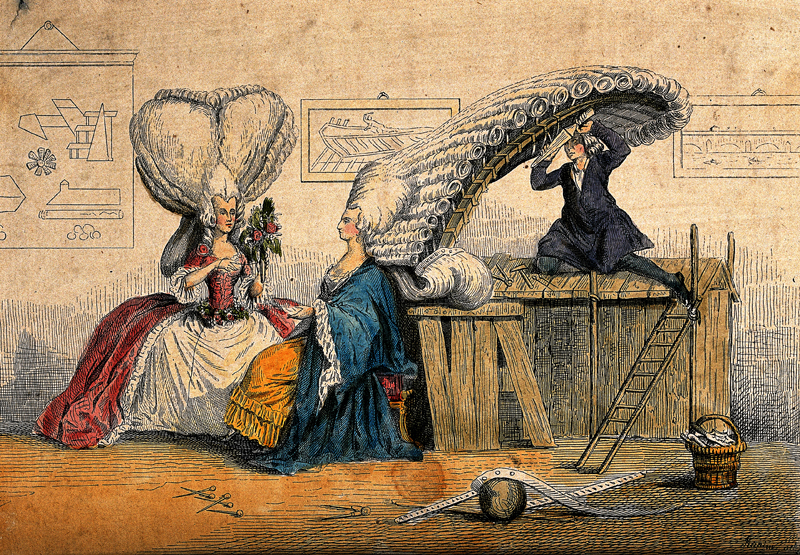
Growing Smarter.
“Public Safety” is also viewed (in private circles) as another opportunity.
“Utilize community-focused, “predictive” policing to ensure public safety in St. Petersburg (BP). Increasingly, urban police departments across the country are relying on sophisticated real-time data systems to analyze crime statistics and proactively address unlawful behavior. These so-called “predictive” policing programs leverage analytics through mapping and historical statistical analysis to target crime hot spots and chronic perpetrators in order to better focus resources on crime prevention.”
The ugly reality behind this is revealed by the way the police department — on its “own” volition — locked down the South Side on MLK Day, (see my January 18 article “Black Community Must Control the Police.”
“ACTION 6.2: Ensure the perception and reality of public safety are conducive to growth in tourism and residential demand. … If the perception of local public safety is negative, then it is tantamount to reality for many residents and visitors.”
Which brings us to the city’s almost frenetic obsession with self-promotion.
“Hundreds of millions of dollars has and is being invested in downtown commercial, retail, and residential development. The district is also proving to be a competitive draw for entrepreneurs. … Outside awareness of the competitive position, assets, and opportunities in the City of St. Petersburg must be broadened. To accomplish this, it will be necessary to formalize a multi-channel program to market St. Petersburg outside of Tampa Bay. … online advertising in targeted media, and investment in public relations should be designed and approved as a component of Grow Smarter implementation.”
“If successful, St. Petersburg can legitimately tout itself as the top startup community in Florida, a title that has yet to be claimed. It is not enough to simply promote assets, however. St. Petersburg must concurrently build the capacity to support entrepreneurs and grow businesses in order to deliver on its promises to existing and future prospects.”
There’s the problem. Capitalism depends in its essence on speculation, i.e., anticipated Return on Investment (ROI). Living on its own “Field of Dreams,” it is operating on the assumption of “Build it and they will come.” Yet:
“Many in St. Petersburg’s entrepreneurial community identified a lack of capital as the biggest challenge to growing and sustaining local startups. St. Petersburg is not alone in this regard; most startup communities outside of major capital markets report that funding for all stages of enterprise development is difficult to secure.”
This reveals an enormous vulnerability I will discuss later. The extracts above delineate briefly but in plain English WHAT the city would like to do. HOW they plan to do it is addressed in a 2015 document, the “Grow Smarter Initiative Implementation Plan.” Note that eight “Key Initiatives” are listed in the Strategy document, with “Proceed with holistic strategies to reduce poverty in South St. Petersburg” ranking number two on the list. Those same eight are also listed in the Implementation document, but on that list, reducing poverty comes in dead last. Please contain your shock.
Now they start talking about Power. First:
“[T]he City of St. Petersburg is the most logical entity to serve as “Implementation Coordinator” of the Grow Smarter Strategy.”
The partnership is clarified. The Grow Smarter Strategy was drawn up by what they called the Grow Smarter Steering Committee. Then:
“At its August 21, 2014 meeting and in a follow up survey, the Steering Committee voted unanimously to stay together as the Implementation Committee. While the Committee will have no organizational governance authority over the strategic coordinator or implementation partners, it will nevertheless serve a critical oversight function, ensuring that the key partners engaged in implementation are represented around the table.”
It goes on to explain:
“In order to enhance and formalize the Chamber’s role in economic development, Market Street proposes that an Economic Development Corporation (potentially re-branded) be created as a 501c3, non-profit, public-private affiliate of the St. Petersburg Chamber. It will serve as the Chamber’s economic development division and be governed by a separate Board of Directors. The EDC budget should be comprised of funding from the Chamber, City of St. Petersburg, and, potentially, Pinellas County, along with a host of other sources that legally can contribute to a 501c3 corporation, including government granting entities, community foundations, private foundations, corporate foundations, philanthropists, and other funders.” …
From the St. Pete projected 2018 city budget:
“[T]he long sought goal of establishing a private sector led and city supported Economic Development Corporation (EDC) was realized. … $182,000 is provided to fund our contribution to the implementation of the Grow Smarter program … $100,000 is provided to meet our financial commitment to the EDC.”
“Cornerstone Members” are the St. Pete Chamber of Commerce and the City of St. Petersburg.
To sum up the situation, a few years back, “Kriseman indicated … that he thought downtown had enough apartments and condos.” (Tampa Bay Times). So the Downtown development goal would be to add office space. As the Tampa Bay Times reports:
“[A]s St. Petersburg grows and reshapes its identity as a cultural and entertainment destination, city leaders are concerned that this side of the bay is missing one critical aspect of that mantra.
“We joked the other day in a meeting that sometimes we feel like developers don’t think we do work here,” said the mayor’s chief of staff, Kevin King. … The problem is that not enough people work in downtown St. Petersburg. Community and business leaders hope to change that by adding more high-end office space. St. Petersburg has just 3.4 million square feet of office space, the thinnest of the six submarkets in the region.

But it was such a Smarter plan!
“City leaders fear that if they don’t find a way to add office space, and thus attract more companies, St. Petersburg could cement itself as a commuter suburb for Tampa. Even worse, if another economic downturn hits, the city might not be able to sustain tax revenue if tourism and arts dollars start to dry up. Office space would provide a steadier source of revenue. … As usual in St. Petersburg, there is some resistance to adding another element to an increasingly crowded downtown.”
However, even as construction is booming, it raises the question of where are all those Downtown workers are going to live. Thus the need to clear out the South Side.
For a United Front Against Gentrification.
- We have identified the process underway — Gentrification.
- We have identified some of the financial powers driving this Gentrification.
- We have identified the city government’s public face in making Gentrification happen — the Development Review Commission.
- We have identified the city’s real “master plan” strategy — the Grow Smarter Initiative.
- We have identified the organization “managing” the city’s Gentrification actions — the Chamber of Commerce’s Economic Development Corporation.
Now what?
First a few words on what might actually mean. Traditionally, there is the United Front, and there is the Popular Front. They are occasionally used interchangeably, but they are quite distinct. A United Front is an alliance of organizations and individuals united around a particular issue or set of issues, while maintaining their freedom of action otherwise. Such was the United Front Against Fascism formed by the Black Panther Party in 1969.
In the Popular Front, on the other hand, its members are subsumed under the leadership of capitalist forces and renounce a significant degree of their own independence. The classic example was the Communist Party USA’s participation in Franklin Roosevelt’s New Deal coalition, in which they supported Roosevelt nearly across the board.
The relevance today is that in a United Front Against Gentrification, we could unite with various forces including Democrats around issues directly opposing Gentrification, while maintaining freedom of action otherwise, such as being able to run independent candidates in the electoral arena, even though other Democrats were contending for some of the same seats.
Where is the Green Party?
The Pinellas County Green Party can play an important role in this United Front Against Gentrification. It is not a “single-issue” organization. It understands the linkage between the many facets of Gentrification. It is an electoral organization, and that is one of the fronts where the fight can be conducted. While we see that the real power behind Gentrification — the Chamber of Commerce’s Economic Development Corporation — is a body accountable only to the highest levels of corporate finance, the implementation of their Grow Smarter Initiative must nonetheless be implemented through St. Petersburg city government, in particular the Development Review Commission. That body is appointed by the mayor with the consent of the City Council, and thus provides a target for an aroused electorate.
That United Front — electoral or otherwise — could include individual renters and homeowners facing rent increases or eviction, small business owners whose blocks are being bought up and demolished to make way for condos and office towers, elderly trailer park residents whose trailer parks are to be replaced by luxury housing, environmentalists who see the city’s infrastructure being overwhelmed by uncontrolled construction, and the homeless who are being rousted daily to make the city beautiful for the tourist trade. The city’s Grow Smarter Initiative outlines the plans for doing just that.
But it is critical to recognize that those impacted by Gentrification do not necessarily have uniform interests. The class and racial divides in St. Petersburg are quite stark.
A quick review of the snapshot at the beginning of this article makes obvious the fact that the brunt of Gentrification, from being turned into a “food desert” to police occupation, from raw sewage in the streets to lack of transportation, from political disenfranchisement to horrific schools, makes clear that their plans are well underway.
What is to stop them?
As Gentrification falls squarely on the city’s Black community on the South Side, which is slated for removal, any such United Front, whether named as such or de facto, must be led by the Black community. The organization at the forefront of this is Communities United for Reparations and Economic Development (CURED), a multi-racial organization is fighting to not merely stop this process, but to actually reverse it. They are calling for “Making the South Side Black Again” and their plans include taking back the Dome (Tropicana Field) and turning that monstrous eyesore into affordable housing for the Black community once again. CURED is also committed to pursuing electoral tactics.
A viable force.
CURED grew out of last summer’s Uhuru campaign of Jesse Nevel for mayor of St. Petersburg, and Akilé Cainion (now Akilé Anai) for City Council District 6 (which the Green Party actively supported). They put out a forceful message of Black economic development coupled with Black community of the police and the schools, and an end to police attacks on Black youth. Their supporters turned out in force to every debate, galvanizing those in attendance. While their vote totals were suspiciously low, they succeeded in setting the terms of the political dialogue for all the candidates. In the process, they redefined the very meaning of “reparations” as a positive solution to the damage that has been inflicted in the state that between 1877 and 1950 led the nation in lynchings per capita (and St. Pete had its share).
What made this possible was not simply their message. There are a lot of great messages out there, to which the general response is one of “You and what army?” It was their campaign’s organized force behind their message that gave their message its impact. Similarly, if the South Side can prove itself an organized force, that will have a transformative effect across the city on all those fighting Gentrification.
And CURED is now back in action.
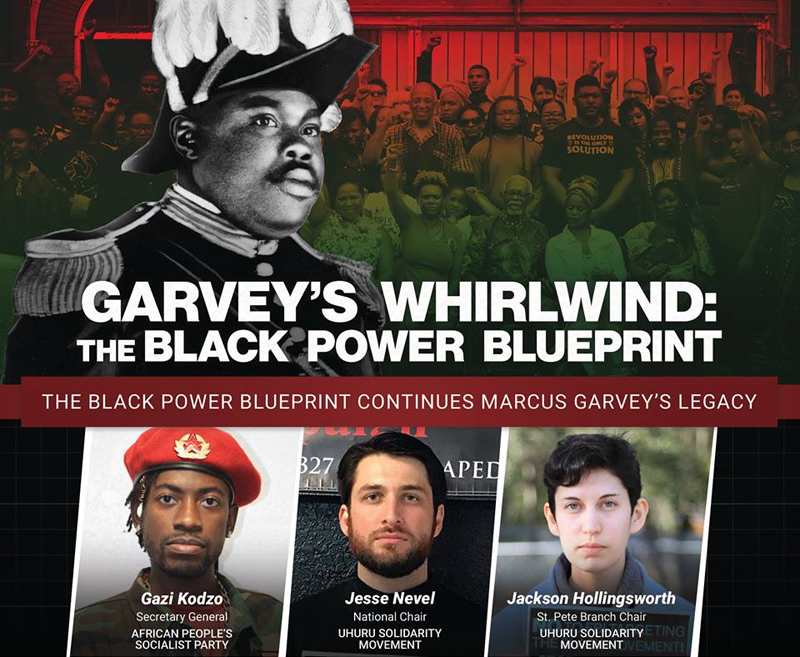
We will stop them!
Defense is not enough.
CURED’s strategic approach is radical to its core. The traditional opposition to Gentrification is one of reactive opposition. Fight this eviction, stop that high-rise, etc. These fights have to be fought. They are in many cases fights for survival, and cannot be ignored. But a strictly defensive strategy is a losing strategy. It puts us in the position of mainly opposing what the developers are billing as “progress.” And in not posing an alternative vision of what progress could really be, the community will find itself beaten down piece by piece.
That vision is already being built, piece by piece, with taking back the Dome only one piece of the puzzle. The Uhuru movement that spawned CURED was also the creator of the African People’s Education and Defense Fund (APEDF), the “Baddest Non Profit on the Planet!” In its welcoming statement, APEDF states, “Driven by African self-determination, APEDF is deeply rooted in the community, provides genuine solutions to this unjust reality, builds institutions and programs where African people are in control of our own community life. This includes economic development in the hands of the African community: programs to feed, clothe, house and employ our people, programs for public health, human rights, education and positive culture.” In St. Petersburg, those community-owned institutions include:
- Black Power 96.3 FM radio station.
- Akwaaba Hall (a community office and meeting space) at 1245 18th Ave. South.
- Uhuru Jiko (Swahili for “in the kitchen”) Community Kitchen.
- All People’s TyRon Lewis Community Gym.
- Uhuru Design Studio.
(As part of the Black Power Blueprint, a similar array of institutions is being up in St. Louis, bringing the fight against the gentrifiers to that poverty-ridden city.)
While these beginnings only comprise a small portion of the South Side’s ravaged economy, the fact of their community-owned independence, the very fact of their existence gives power to the vision they represent.
Build a “Hostile Development Environment”!
The forces of Gentrification are among the most powerful in the state. But as much as they try to act in concert, capitalism operates under the “anarchy of production.” It depends on myriad individual decisions based on individual expectations of Return on Investment (ROI). Even through their own ambitious planning runs a ribbon of fear. So the Master Plan states:
“St. Petersburg must concurrently build the capacity to support entrepreneurs and grow businesses in order to deliver on its promises to existing and future prospects.”
Promises that they may not be able to keep.
“Many in St. Petersburg’s entrepreneurial community identified a lack of capital as the biggest challenge to growing and sustaining local startups. St. Petersburg is not alone in this regard; most startup communities outside of major capital markets report that funding for all stages of enterprise development is difficult to secure.”
Indeed!
Inordinate space in their Strategy, Implementation and Vision documentation is devoted to marketing the city to tourists and investors
“Hundreds of millions of dollars has and is being invested in downtown commercial, retail, and residential development. The district is also proving to be a competitive draw for entrepreneurs. … Outside awareness of the competitive position, assets, and opportunities in the City of St. Petersburg must be broadened.”
They want to project that St. Petersburg is a good place to visit. A good place to live. A good place to invest. But what happens if that happy image of teeming tourists, towering condos, gleaming office towers and frolicking Black families — “one of the brightest spots in the Southeast, not only as a business location, but as a home for a talented workforce” — gets punctured?
 What if CURED and others, fighting back to save their homes and their families and their small businesses, create what CURED calls a “hostile development environment”? Hostile to developers and gentrifiers, that is. Then they can be beaten.
What if CURED and others, fighting back to save their homes and their families and their small businesses, create what CURED calls a “hostile development environment”? Hostile to developers and gentrifiers, that is. Then they can be beaten.
— Jeff Roby
June 26, 2018
References:
2-Cautionary Tales by Jeff Roby
3-Jeff Roby on Strategy and Tactics
4-An Interesting Conversation on the Way Forward by Rose Roby
5-On Becoming Dependent Upon Incarceration by Rose Roby
6-The Democratic Party is the More Effective of Two Evils by Rose Roby and two others
7-An Interview with Don DeBar about Jill Stein's Strange Support of Clinton by Jeff and Rose Roby
8-We, too, are “Deplorables” (Part 2 of An Interview with Don DeBar about Jill Stein's Strange Support of Clinton) by Jeff and Rose Roby
9-Gentrification and Orange County by Jeff Roby
